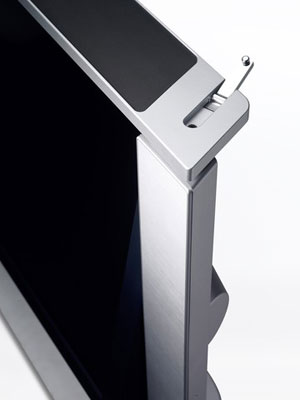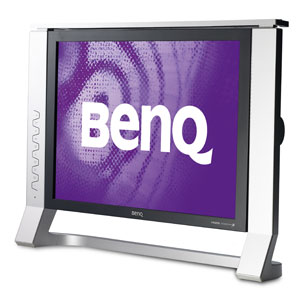|
|
||||
I'm not much of a gamer, but I can't argue with them. The games I tried, which included Quake 4 and others, looked great, and the hesitation that LCD's are prone to sometimes was well controlled. BenQ's PerfectMotion dynamic video processing technology, which features adjustable settings accessed by a button on the left side of the unit, lets gamers enjoy an experience that's pretty well free of ghosting and motion blurring. Nothing's perfect, of course, and this is far from the most high end monitor one can get, but it's pretty darn good for the price.
 BenQ says the system uses two steps to "ensure that frustrating, game-inhibiting ghosting and motion blur around the screen edges are eliminated." The first step is to reduce the grey-to-grey response time before, secondly, inserting a black frame between the motion frames to give "crystal-clear view, ultra-smooth motion."
BenQ says the system uses two steps to "ensure that frustrating, game-inhibiting ghosting and motion blur around the screen edges are eliminated." The first step is to reduce the grey-to-grey response time before, secondly, inserting a black frame between the motion frames to give "crystal-clear view, ultra-smooth motion."
The company also claims a 12ms MPRT (Motion Picture Response Time) to also help smooth the playback of, as they say, "even the most action-packed visual content". And BenQ's Senseye Technology "automatically and dynamically improves image quality" by emulating the human eye by fine-tuning the color, clarity, motion and contrast.
They haven't forgotten "garden variety" computer users and home theater lovers, either, thanks to six display modes including Action Game, Racing Game, Photo, Dynamic, and the much loved "Standard". There's also a movie setting I favored when trying the monitor with 1080p material.
You can access the various modes directly via a button on the left-mounted control panel, which is nice because the menu system itself is rather ponderous.
Other buttons on the control panel include Enter/PIP, menu navigation and contrast, Input and the PerfectMotion controller. The control panel is on one of the two vertical legs of the "frame" from which the screen is hung – a handsome way of doing things. The frame also includes a little top shelf on which you can put stuffed animals or anything else that's light enough and won't spill liquid into the works.
BenQ also gives you a little hook from which you can hang your headphones, and the semi-oval style of the stand's bottom lets you park your keyboard under the monitor when you aren't using it, unless your desktop is like mine and that space ends up crowded with junk.
The screen itself tilts to reasonable angles up and down, offers a contrast ratio of 1000:1, which is decent for a PC monitor these days, and BenQ says it can display some 16.7 million colors. I only counted 16.69, however. Just kidding!
And it comes with about all the connections you could need, including HDMI 1080p capability, DVI (which is how I hooked the BenQ into my PC), as well as D-sub, S-Video, composite and component. It also has USB connection.
I used it with my PC not only for gaming, but as my primary monitor. The 24 inch screen size is wonderful, and I used it side by side with my normal 20 inch monitor, the latter used as a second display to which I stretched my Windows desktop.
But it's the 1080p capability that really turns my crank. This moves the BenQ from the realm of the desktop computer and puts it squarely in the world of home theater, where it's perfect for a small (or computer-based) home theater, corporate boardroom or lobby, or the student living in a dorm who wants the flexibility of a monitor and an HDTV (remember, though, you have to add an HD source, just like you have to add a computer source).
The BenQ offers full 1920x1080 resolution and its native resolution is 1920x1200, which is great when you're using it as a computer monitor (it's the resolution I used all the time unless a particular software title demanded it be "dumbed down"). It's a bit screwy as a home theater screen, though, because the extra pixels from top to bottom (1080 vs 1200) can lead to a stretching of the picture from top to bottom.
You can tweak this back to a normal 1080 pixels aspect ratio fairly easily via the menu system, which results in a mild "letterboxing" effect (small black bars above and below the screen) – a more than acceptable compromise between the PC and HDTV worlds.
I didn't have a chance to try the BenQ with Blu-ray or HD DVD sources while writing this piece, but I did watch some regular DVD's up converted to 1080p via two DVD players of wildly varying prices. The results weren't as good as real HD discs, not surprisingly, and not as good as with our reference 1080p screen, but for the price of this unit it was quite acceptable. High definition TV, watched at 1080i and 720p, looked good as well.
As a computer monitor, the screen size, resolution and wide screen aspect ratio were great. There was enough elbow room that I could drag text from one document and drop it directly into another without having to go through the taskbar and it was great to have multiple documents open side by side and still be able to read them.
I mentioned above how the BenQ (or, to be fair, any second monitor) let me use two monitors simultaneously, and how delightful that is, thanks the small footprint of LCD's, which leave enough room on my "brick and mortar" desktop for the rest of my junk. I'd use the feature to keep windows that I run minimized or in the background normally (such as my email program and the Windows Vista sidebar) on the second monitor, where they're visible and accessible immediately.
That isn't really a selling point for this monitor, but it's sure nice when you can get it. It made me pine for four monitors (one for the front, rear, left and right) and a good flight simulator or first person shoot 'em up that would exploit them.
Now that would be gaming!
I did have an intermittent problem with the BenQ: once in a while (about four times in a couple of months with the monitor) it would go a bit fuzzy, as if there were electrical or magnetic interference close by. I never found out the cause, and it would go away if I shut off the monitor and fire it back up again, so it wasn't a big deal (though it shouldn't have done it!).
Seems to me that this is a good monitor at a good price, and an excellent way to exploit 1080p sources economically (as long as you don't need a really big screen). It's more expensive than a similarly-sized (and very good) LG monitor I reviewed a couple of months ago, but its added emphasis on gaming performance and (yes, it's superficial, but I admit it) its more handsome and solid look may make it worth the premium if such things are important to you.
Jim Bray's columns are available through the TechnoFile Syndicate.
 BenQ Monitor Doubles as a High Def TV
BenQ Monitor Doubles as a High Def TV